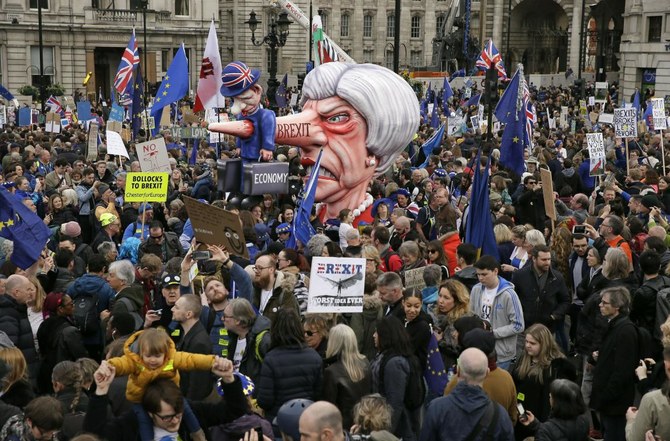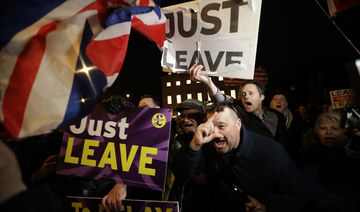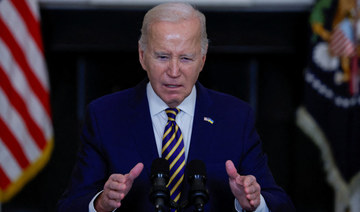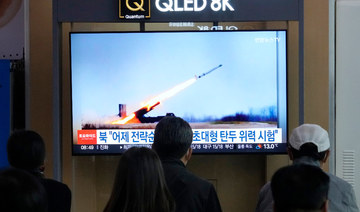LONDON: Hundreds of thousands of people opposed to Britain’s withdrawal from the European Union marched through central London on Saturday to demand a new referendum as the deepening Brexit crisis risked sinking Prime Minister Theresa May’s premiership.
After three years of tortuous debate, it is still uncertain how, when or even if Brexit will happen as May tries to plot a way out of the gravest political crisis in at least a generation.
Marchers set off in central London with banners proclaiming “the best deal is no Brexit” and “we demand a People’s Vote” in what organizers said was more than one million people strong and the biggest anti-Brexit protest yet.
“I would feel differently if this was a well-managed process and the government was taking sensible decisions. But it is complete chaos,” Gareth Rae, 59, who traveled from Bristol to attend the demonstration, told Reuters.
“The country will be divided whatever happens and it is worse to be divided on a lie.”
While the country and its politicians are divided over Brexit, most agree it is the most important strategic decision the United Kingdom has faced since World War Two.
Thousands of pro-EU protesters gathered for the “Put it to the people march” at Marble Arch on the edge of Hyde Park around midday, before marching through the landmarks Picadilly Circus and Trafalgar Square and past the prime minister’s office in Downing Street to finish outside parliament.
March organizers estimated that more than one million people turned out for the march, exceeding a similar rally held in October, when supporters said about 700,000 people turned up.
It was not possible to independently verify the figure, although a Reuters reporter said the march was so busy that some of the crowd had to be diverted off the main route. Police declined to give an estimate on the number of protesters.
The one million estimate would make it London’s second biggest demonstration after a rally against the Iraq War in February 2003, which organizers said close to 2 million people attended.
“NEVER GONNA GIVE EU UP“
A range of politicians, including from the governing Conservative Party, addressed a crowd, which packed out Parliament Square and left some unable to get near.
Among them was Labour’s deputy leader Tom Watson, who swung behind a People’s Vote on May’s deal despite party leader Jeremy Corbyn’s reticence on the issue, and Scottish National Party leader Nicola Sturgeon.
Phoebe Poole, 18, who was holding a placard saying “never gonna give EU up” in reference to a song by 1980s popstar Rick Astley, was not old enough to vote in the 2016 referendum.
“We have come here today because we feel like our future has been stolen from us. It is our generation that is going to have to live with the consequences of this disaster,” she told Reuters.
“It is going to make it harder to get a job. You are already seeing a lot of large companies leaving. I am worried about the future.”
Two hundred coaches from around Britain were booked to take people to London for the march.
A petition to cancel Brexit altogether gained 4.39 million signatures in just three days after May told the public “I am on your side” over Brexit and urged lawmakers to get behind her deal.
But protesters disagreed with May’s claim that she is on the side of the British public, with one placard reading: “You do not speak for us Theresa.”
In the June 23, 2016 referendum, 17.4 million voters, or 52 percent, backed Brexit while 16.1 million, or 48 percent, backed staying in the bloc.
But ever since, opponents of Brexit have been exploring ways to hold another referendum. Some opinion polls have shown a slight shift in favor of remaining in the European Union, but there has yet to be sustained evidence of a decisive change in attitudes.
May has repeatedly ruled out holding another Brexit referendum, saying it would deepen divisions and undermine support for democracy. Brexit supporters say a second referendum would trigger a major constitutional crisis.
Those favoring Britain remaining in the EU say Brexit will bring economic hardship and disrupt trade, as well as an end to many social benefits, including the right to live and work in 27 other countries.
Supporters of Brexit say the divorce might bring some short-term instability, but in the longer term Britain will thrive if cut free from what they cast as a doomed experiment in German-dominated unity that is falling far behind other major powers.
“We already put it to the people. And the people roared,” pro-leave group Change Britain said in a tweet.
Hundreds of thousands march in London to demand new Brexit referendum
Hundreds of thousands march in London to demand new Brexit referendum

New film captures Afghan women’s courage in failed peace talks with Taliban

- Directed by Roya Sadat, the 95-minute “The Sharp Edge of Peace” is a testament to the courage of Afghan women leaders
- Fawzia Koofi and other leaders continue advocating for change since Taliban seized power in 2021 and curtailed women’s rights
TORONTO: The new documentary “The Sharp Edge of Peace” begins with a harrowing scene: Fawzia Koofi, a former member of Afghanistan’s parliament and a women’s rights activist, recovering in a hospital bed after surviving an assassination attempt in August 2020.
While traveling to Kabul with her daughter, Koofi was ambushed by unidentified gunmen who opened fire on her vehicle.
“They thought I was shot in the head and died,” Koofi says in the documentary, which has its world premiere on Saturday at the Canadian documentary festival Hot Docs that runs through May 5.
Directed by Roya Sadat, the 95-minute film is a testament to the courage of Afghan women leaders who continue advocating for change since the Taliban seized power in August 2021, and have drastically curtailed women’s freedoms and rights.
“This is a tragedy, but at the same time, you can see the power of women and see the beauty of this country when women participate,” Sadat told Reuters.
Koofi’s resolve remained unshaken even after the attack, which was not the first she’s faced.
She was a key figure among women negotiators, including Fatima Gailani, Habiba Sarabi, and Sharifa Zurmati, involved in the intra-Afghan talks in Doha, Qatar aimed at striking a peace deal with the Taliban.
The documentary covers the failed negotiations from the perspective of the women on Afghanistan’s negotiating team.
Once at the negotiating table, Koofi realized the Taliban already saw themselves as victorious.
“When President Biden came to power, he announced that he would withdraw his troops from Afghanistan regardless, with no conditions, and that was a boost to the Taliban’s morale,” she said in an interview.
The Biden administration has previously blamed the chaotic US withdrawal on the Trump administration, which struck the agreement with the Taliban.
‘WE ARE BEING ERASED’
Koofi, now in exile, continues to work from the UK by engaging with international bodies like the United Nations and the European Union, pushing policymakers to recognize the plight of Afghan women under Taliban rule.
“It’s painful that most of these countries think that we should influence and change the perspectives of the Taliban,” Koofi said, adding that since regaining power, they have not changed at all.
“We are being erased,” Koofi said of the steady decline in women’s rights in Afghanistan.
Undeterred, Koofi founded the Afghan Women Coalition for Change with a goal of establishing gender apartheid as an internationally recognized crime against humanity.
Gailani, chair of Afghanistan Future Thought Forum, told Reuters the negotiating team never wanted US soldiers or NATO to stay in the country forever, but expected a smoother withdrawal and a political settlement.
“Some Westerners believe that they alone gave freedom to the Afghan woman, that she couldn’t do anything herself, which is not the case,” says fellow negotiator Sarabi at the close of the film. “Afghan women didn’t get here easily, they endured a lot of struggles.”
Death toll from south China road collapse rises to 36

- The death toll was up from 24 people on Wednesday afternoon
- Vehicles careened into the nearly 18-meter-long gash in the tarmac and plummeted down the steep slope below
Beijing, China: The death toll from a highway collapse in southern China’s Guangdong province has risen to 36, state media said Thursday, as rescue work continued.
Heavy rains caused a stretch of road running from Meizhou city toward Dabu county to cave in at around 2:10 am on Wednesday (1810 GMT Tuesday), according to state news agency Xinhua.
Vehicles careened into the nearly 18-meter-long (59-foot) gash in the tarmac and plummeted down the steep slope below.
Guangdong, a densely populated industrial powerhouse, has been hit by a string of disasters attributed to extreme weather events in recent weeks.
The storms have been much heavier than expected this time of year and have been linked to climate change.
China is the biggest emitter of the greenhouse gases that contribute to climate change but has pledged to reduce emissions to net zero by 2060.
“As of 5:30 am on (Thursday)... 36 people have died, and 30 people have been injured,” Xinhua said, adding that the injuries were not life-threatening.
The death toll was up from 24 people on Wednesday afternoon.
Footage by state broadcaster CCTV showed excavators digging through the muddy hillside below the collapsed road.
Nearby, a crane lifted charred, wrecked vehicles onto a lorry as people watched from behind a cordon.
State media called the road collapse a “natural geological disaster” caused by the “impact of persistent heavy rain.”
President Xi Jinping ordered officials to “go all-out in on-site rescue work and treatment of the injured, and arrange for the management of risks and hidden dangers in a timely manner,” CCTV said on Thursday.
Around 500 people have been dispatched to help with the rescue operation, it added.
The provincial government has “mobilized elite specialized forces and gone all out to carry out... search and rescue,” according to Xinhua.
An official notice on Wednesday advised that part of the S12 highway was closed in both directions, requiring detours.
Parts of central and eastern Guangdong have received up to 600 millimeters of rain in the last 10 days, three times the amount normally expected at this time of year, the national weather office said Thursday.
Up to 120 millimeters more rain was forecast for the province’s southwestern areas on Thursday, alongside further downpours across southern China until Sunday.
The conditions “raise the risk of disasters, especially geological disasters, which have a certain lag time,” the weather office said.
The emergency management ministry also warned that persistent rain would make such disasters more likely.
Officials have warned people to plan journeys carefully during the May public holiday, which runs until Sunday.
Massive downpours in Guangdong last month sparked floods that claimed four lives and forced the evacuation of more than 100,000 people.
And last week, a tornado killed five people when it ripped through the megacity of Guangzhou.
South Korea parliament approves bill on new inquiry into deadly 2022 crowd crush

- An earlier bill was vetoed by President Yoon Suk-yeol
SEOUL: South Korea’s National Assembly voted on Thursday to approve a bill backed by the ruling and opposition parties to launch a fresh probe into the deadly Halloween crowd crush in the capital Seoul in 2022.
An earlier bill, which was backed the opposition-led parliament without the support of the ruling People Power Party (PPP), was vetoed by President Yoon Suk-yeol in January.
The latest bill is a compromise that removes granting full investigative power to the panel, which Yoon had objected to, according to his office.
Under the bill, a committee made up of members recommended by two major parties and a chair chosen by them through consultations will look into the tragedy.
The passage of the bill comes after Yoon met opposition leader Lee Jae-myung of the Democratic Party for talks on Monday following the PPP’s crushing general election defeat last month.
It also comes amid growing pressure on authorities, including from relatives of the victims, to hold those responsible to account.
A spokesperson for Yoon on Wednesday welcomed the agreement reached between the ruling and opposition parties on the bill as indicating a return to cooperation in politics.
The Halloween crowd crush in Seoul’s Itaewon district in 2022 killed nearly 160 people and relatives of the victims as well as the United Nations Human Rights Committee have since called for an independent inquiry.
A police investigation published early last year concluded that a lack of preparation and an inadequate response were the main factors behind the deadly crush.
In January, South Korean prosecutors indicted the former head of the Seoul Metropolitan Police Agency, charging him with contributing through negligence to the crush.
No senior government figures, including the interior and safety minister, have resigned or been sacked so far over the crush.
Extreme heat shuts schools for millions, widening learning gaps worldwide

- Bangladesh, Philippines, India announce school closures
- High temperatures slow down the brain’s cognitive functions, lowering pupils’ ability to retain and process information: study
Hena Khan, a grade nine student in Dhaka, has struggled to focus on her studies this week as temperatures surpassed 43 degrees Celsius (109 degrees Fahrenheit) in the Bangladesh capital.
“There is no real education in schools in this punishing heat,” she said. “Teachers can’t teach, students can’t concentrate. Rather, our lives are at risk.”
Khan is one of more than 40 million students who have been shut out of classrooms in recent weeks as heatwaves have forced school closures in parts of Asia and North Africa. As the climate warms due to the burning of fossil fuels, heatwaves are lasting longer and reaching greater peaks.
In turn, government authorities and public health experts across the world are increasingly grappling with whether to keep students learning in hot classrooms, or encourage them to stay home and keep cool.
Either decision has consequences. About 17 percent of the world’s school-aged children are already out of school, according to United Nations data, but the proportion is much larger in developing countries with nearly a third of sub-Saharan Africa’s children out of school compared to just 3 percent in North America.
Child test scores in the developing world also lag developed countries.

Heat could exacerbate inequalities, widening learning gaps between developing nations in the tropics and developed countries, experts told Reuters, and even between rich and poor districts in wealthy countries. But sending children to overheated schools could make them ill.
South Sudan already this year closed its schools to some 2.2 million students in late March when temperatures soared to 45 degrees Celsius (113 Fahrenheit). Thousands of schools in the Philippines and in India followed suit in late April, closing classrooms to more than 10 million students.
On Wednesday, Cambodia ordered all public schools to slash two hours off the school day due to avoid peak heat at midday.
Meanwhile, Bangladesh has wavered between opening and closing schools for some 33 million students amid pressure to prepare pupils for exams — even as temperatures climb to dangerous levels.
Many Bangladeshi schools “don’t have fans, the ventilation is not good, and they might have tin roofing which does not provide good insulation,” said Shumon Sengupta, Bangladesh country director for nonprofit Save the Children.
Hot heads
Even if students continue attending classes during heatwaves, their education is likely to suffer.
High temperatures slow down the brain’s cognitive functions, lowering pupils’ ability to retain and process information. US high schoolers, one 2020 study found, performed worse on standardized tests if they were exposed to higher temperatures in the year leading up to the exam.
The research, published in the American Economic Journal, found that a 0.55C (1F) warmer school year reduced that year’s learning by 1 percent. Much of that impact disappeared in schools that had air conditioning, said study co-author Josh Goodman, an economist at Boston University.
Between 40 percent and 60 percent of US schools are thought to have at least partial air conditioning, according to various surveys. Schools without it are often found in poorer districts which already trail their wealthier counterparts academically.
Goodman and his colleagues found similar learning outcomes tied to heat when they looked at standardized test data in other countries. “When (students in) these places experience a year with more heat, they appear to have learned less,” he said.
Other research suggests excessive heat in the tropics can also impact a child’s education even before birth.
Children in Southeast Asia exposed to higher-than-average temperatures in utero and early in life obtained fewer years of schooling later in life, a 2019 study in the Proceedings of the National Academy of Sciences found.
All of this is worrying, Goodman said, because as the world warms, already hot countries shifting to an extremely hot climate will suffer more than temperate countries.
“Climate change will widen the learning gaps between hot and cool countries,” Goodman said. Some developed countries are trying to address the issue.
In March, the US Agency for International Development (USAID) announced it would build 30 heat-resilient schools in Jordan by 2026 “to address the projected increase in extreme heat days in Jordan,” a USAID spokesperson said.
Providing details not previously reported, USAID said it would invest $8.17 million in the schools, using passive cooling systems and air conditioning to help keep schools operating. The number of days that schools are closed for extreme heat has been ticking up in the US, but few countries track such data.
US schools are now canceling class for an average of six to seven school days each year for heat, compared with about three to four days a decade ago, said Paul Chinowsky, a civil engineer who led a 2021 study on schools and rising temperatures for the firm Resilient Analytics.
In Bangladesh last year, schools were closed for 6-7 days, said Save the Children’s Sengupta. “But this year, they are saying it might be closed for 3 to 4 weeks,” he said, as May is often the hottest month in South Asia.
Pro-Palestinian banners. Blazing Olympic rings. Workers’ May Day rallies confront turbulent times

ISTANBUL: Workers and activists around the world marked May Day with largely peaceful protests Wednesday over rising prices, low wages and calls for greater labor rights. Pro- Palestinian sentiments were also on display.
Police in Istanbul used tear gas and fired rubber bullets to disperse thousands of people who tried to break through a barricade and reach the main Taksim square in defiance of a ban. Interior Minister Ali Yerlikaya said at least 210 people were detained.
President Recep Tayyip Erdogan’s government has long declared Taksim off-limits for demonstrations on security grounds. In 1977, unidentified gunmen opened fire on a May Day celebration there, causing a stampede and killing 34 people. On Wednesday, a small group of trade union representatives lay a wreath at a monument to victims.
May Day, which falls on May 1, is observed to celebrate workers’ rights. It’s also an opportunity to air economic grievances or political demands. “Tax the rich,” one banner in Germany read. “Don’t touch the eight-hour workday!” another read in Sri Lanka.
In Paris, police fired tear gas as thousands of protesters marched through the French capital, seeking better pay and working conditions. Police said 12 officers were hospitalized after a homemade explosive was set off on the sidelines of the march and at least 45 people were detained after instances of scattered violence
A group of protesters set makeshift Olympic rings on fire to show discontent with the Summer Games that start in less than three months. France’s unions have warned of a strike during the Games if the government does not adequately compensate people forced to work during summer holidays.
Pro-Palestinian groups joined the Paris rally, chanting slogans in support for people in Gaza. There were similar scenes in other parts of the world. In Greece, pro-Palestinian protesters joined May Day rallies, waving a giant Palestinian flag as they marched past the Greek parliament. Others displayed banners in support of pro-Palestinian protesting students in the United States.
“We want to express our solidarity with students in the United States, who are facing great repression of their rights and their just demands,” said Nikos Mavrokefalos at the march. “We want to send a message that workers say no to exploitation, no to poverty, no to high prices,” he added.
Several thousand protesters joined the Athens marches as labor strikes disrupted public transport across Greece. The largest union demands a return to collective bargaining after labor rights were scrapped during the 2010-18 financial crisis.
In the German capital, around 11,600 people marched through the immigrant neighborhoods of Kreuzberg and Neukoelln, waving Palestinian flags and holding banners that read “No weapons for Israel” or “Free Palestine,” German news agency dpa reported.
Throughout Latin America, workers marched to protest austerity measures and demand higher wages. In Argentina, unions galvanized crowds to vent their rage over libertarian President Javier Milei’s economic policies, which they say benefit the wealthy while inflicting pain on the poor and middle class.
“Paying rent is difficult, buying rice is difficult, everything under this guy (Milei) is difficult,” said 40-year-old garbage collector Leandro Rosas, trailing protesters down the street with a broom because this May Day, he said he couldn’t even surrender a shift’s pay.
Meanwhile, Bolivian President Luis Arce joined the workers’ march and decreed a 5.8 percent increase in the national minimum wage, a bid to mobilize support as a worsening economic crisis raises the specter of social unrest. The thousands-strong protests in Santiago, Chile, turned violent in some areas as security forces unleashed water cannons and tear gas on corwds, drenching and dispersing protesters who vandalized shops and government buildings.
In Brazil, President Luiz Inácio Lula da Silva ratified a law that extends income tax exemptions to those earning up to two minimum wages per month, or about $544.
“In our country there will be no tax breaks to favor the richest, but to favor those who work and live off their wages,” Lula told a crowd sweltering in the sun at a soccer stadium in São Paulo.
In Nigeria, where inflation is the highest in 28 years, at over 33 percent, unions demanded bigger salary increases. In South Africa, pro-Palestinian demonstrators joined May Day events and in Kenya, President William Ruto called for an increase in the country’s minimum wage.
In Lebanon, pro-Palestinian marchers mingled with workers demanding an end to a miserable economic crisis. “Politicians do not feel the pain of the worker or the economic conditions,” said one demonstrator, Abed Tabbaa. In Iraq, protesters demanded better wages, the reopening of closed factories and the end to privatization of certain businesses.
Tens of thousands Sri Lankans paraded through the capital as the country struggles through its worst economic crisis, two years after declaring bankruptcy. Discontent has grown over efforts to increase revenue by raising the price of electricity and imposing taxes on professionals and small businesses.
In South Korea’s capital, thousands of protesters shouted pro-labor slogans at a rally that organizers said was meant to step up criticism of what they call anti-labor policies pursued by President Yoon Suk Yeol’s conservative government.
“In the past two years under the Yoon Suk Yeol government, the lives of our laborers have plunged into despair,” Yang Kyung-soo, leader of the Korean Confederation of Trade Unions, said in a speech. Union members criticized Yoon’s recent veto of a bill aimed at limiting companies’ rights to seek compensation for damages caused by union strikes.
In Japan, more than 10,000 people gathered in Tokyo, demanding salary increases to set off price increases.
Indonesian workers demanded protections for migrant workers abroad and a minimum wage raise. They gathered amid a tight police presence, chanting slogans against the new Job Creation Law and loosened outsourcing rules.
In the Philippines, hundreds of workers and left-wing activists marched to demand wage increases and job security amid soaring food and oil prices. Riot police stopped them from getting close to the presidential palace.




















